Section 2.1 Small Number and the Old Canoe - Classroom Guide
View the full story: Small Number and the Old Canoe
Suggested Grades: 3 – 7
Subsection 2.1.1 Mathematics
- counting
- patterns
- shapes
- mathematical thinking
- inclusion-exclusion formula
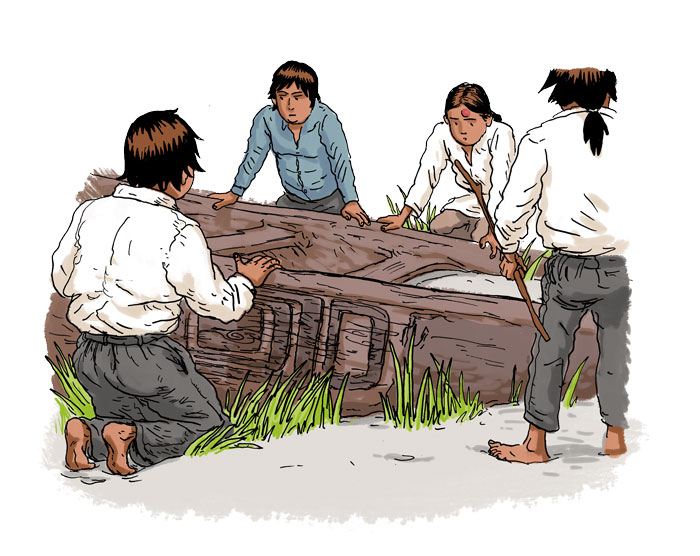
Subsection 2.1.2 Mathematical Vocabulary
small, number, 5-year-old, down, circle, the farthest, surface, quickly, to go far, smooth, flat, oval shaped, wanders far along the shore, tall, falling headfirst, into, stands up, looks around, stand around, along its smooth shape, very old, very big, How many?, How many generations ago?, long time, run back, huge, at least a hundred years old, the fastest, two of his brothers, all (the sons of my grandfather), three old totem poles, in front of the longhouse, each of them, by one of (my uncles), just before, two, three, four, five or more.
Subsection 2.1.3 Cultural Components
-
Indigenous:
- Grandpa’s hat: Many First Nations along the Pacific Northwest Coast have tradition of wearing woven hats. Learn more about how these hats are made. You may start with the SFU Museum of Archeology: Haida Hats.
- Grandpa’s blanket: Maybe you’ve noticed that some Indigenous people wear blankets during various ceremonies. Learn more about traditional button blankets. You may start here: Button Blankets.
- Canoe: Canoes have been one of the most important means of transportation along the Pacific Coast. Learn more about the traditional use of canoes and the ways they were built. You may wish to start with: the SFU Museum of Archeology (Waterways), the SFU Bill Read Centre (Northwest Coast Canoes), and the Canadian Encyclopedia (Birchbark Canoes).
- Totem poles: Draw and describe a totem pole that you have recently seen. Learn more about traditional totem poles. You may start with the SFU Museum of Archeology: Building a totem pole.
- Feast dish: A potlatch is a feast practiced by Indigenous peoples of the Pacific Northwest Coast. Traditionally, during a potlatch food was served in so-called “feast dishes”. Learn more about feast dishes. You may wish to start with the UBC Museum of Anthropology: MOA - Feast Dish.
-
General:
- Have you ever tried skipping stones across the water? If yes, share your story. Do you think that the shape of the stone matters?
- Have you ever been in a canoe or a kayak? If yes, share your story.
- Have you ever made your grandparents worried by something that you did?
- What do you know about your great-grandparents?
- Have you ever encountered a mathematical question that had more than one possible answer?
Subsection 2.1.4 Mathematical Observations (Video)
Click here to see the film (English)
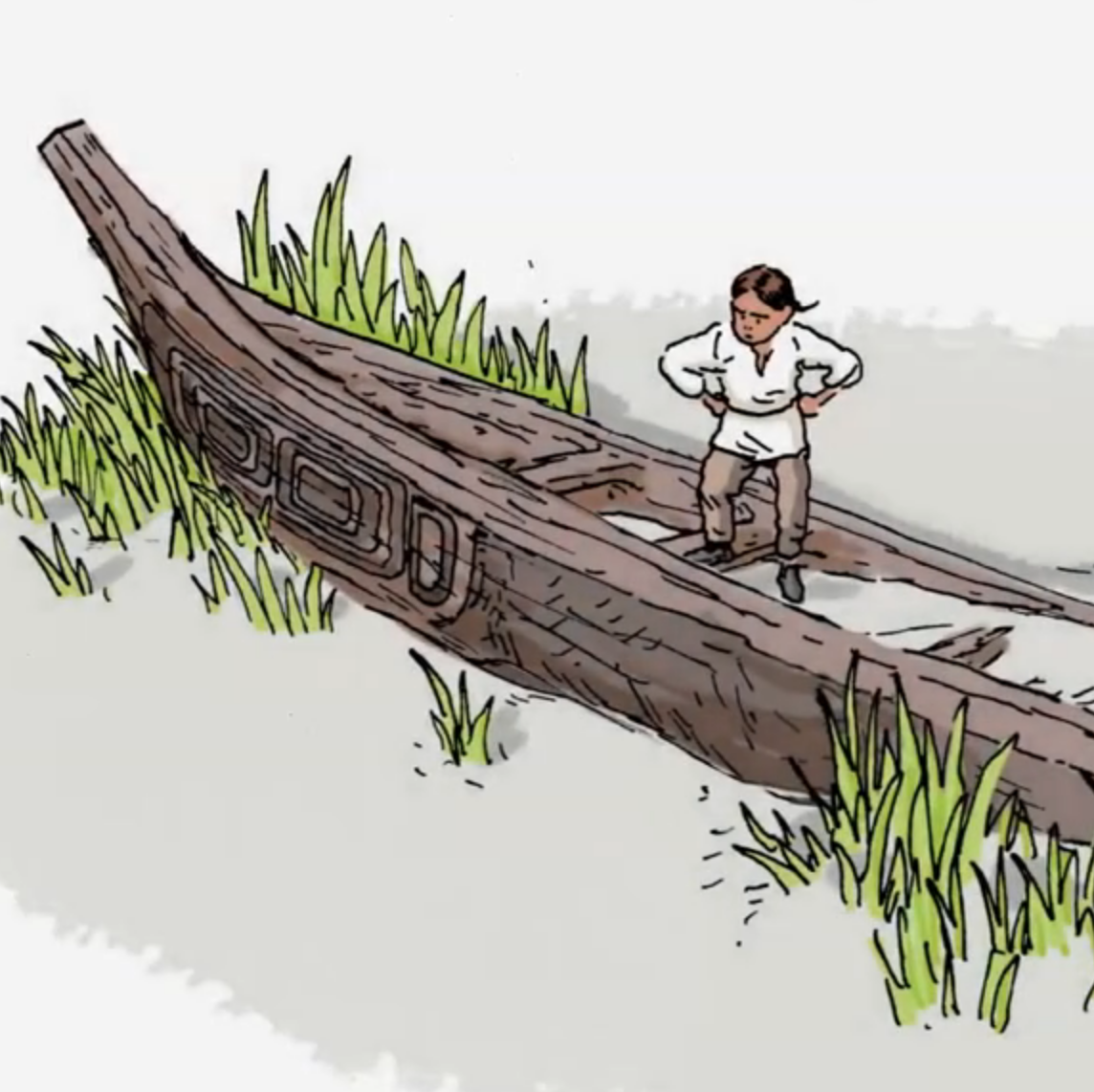
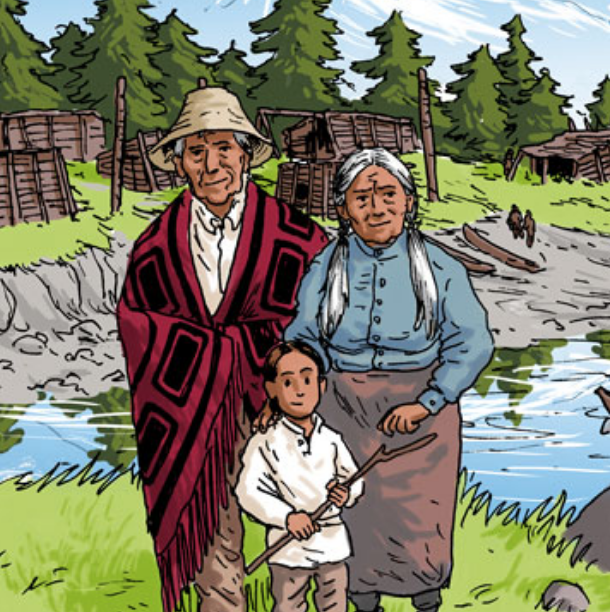
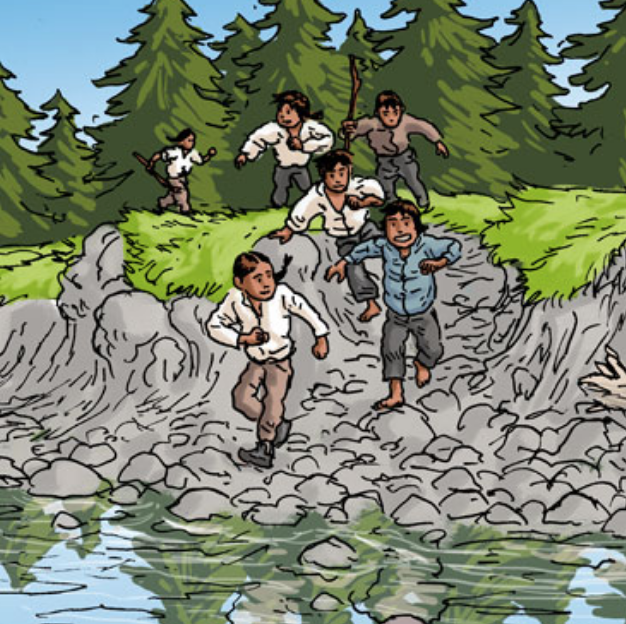
Opening scene: Notice the shape of the canoe and the shapes of the carvings on its side.
0:15 - Notice the shapes of Grandpa’s hat, the mountain peaks, and the trees. How long is Small Number’s stick?
0:24 - How many boys are there? Notice their reflections in the water.
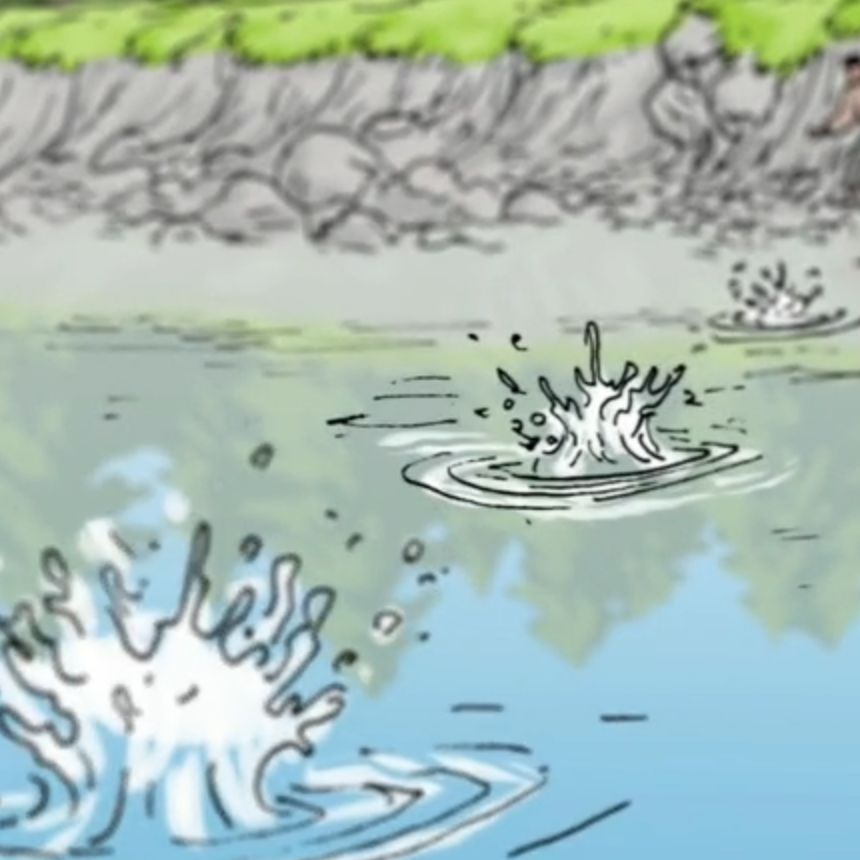
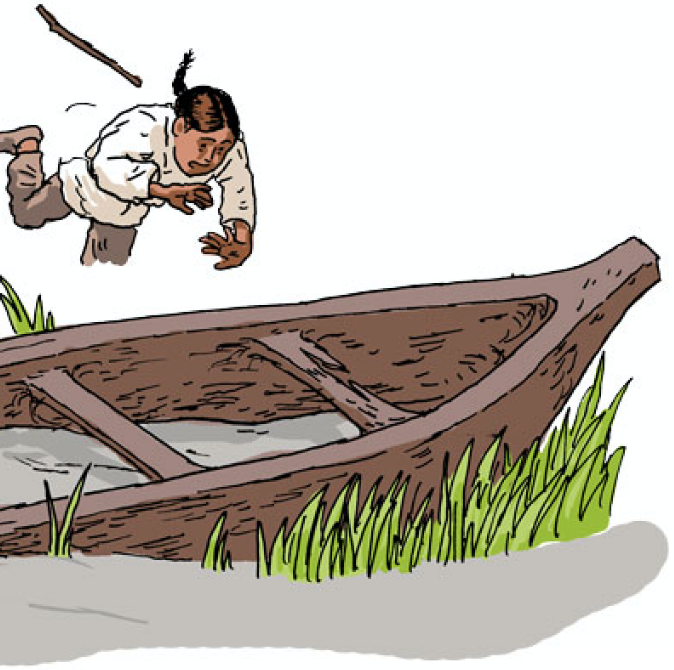
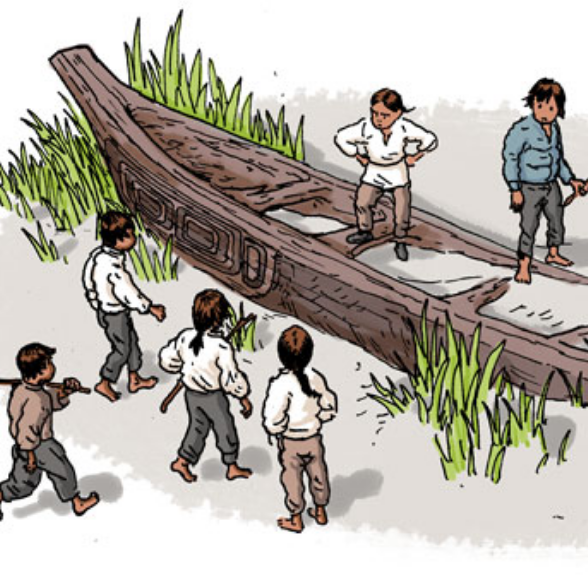
0:38 - 0:41 - What is the shape of the stone? Notice the pattern made by the skipping stone. How many times did it skip? Notice the perspective. “For a stone to go far it needs to be smooth, flat, and oval shaped.”
1:00 - What is the shape of the canoe?
1:17 - “How many people do you think [the canoe] could hold?”
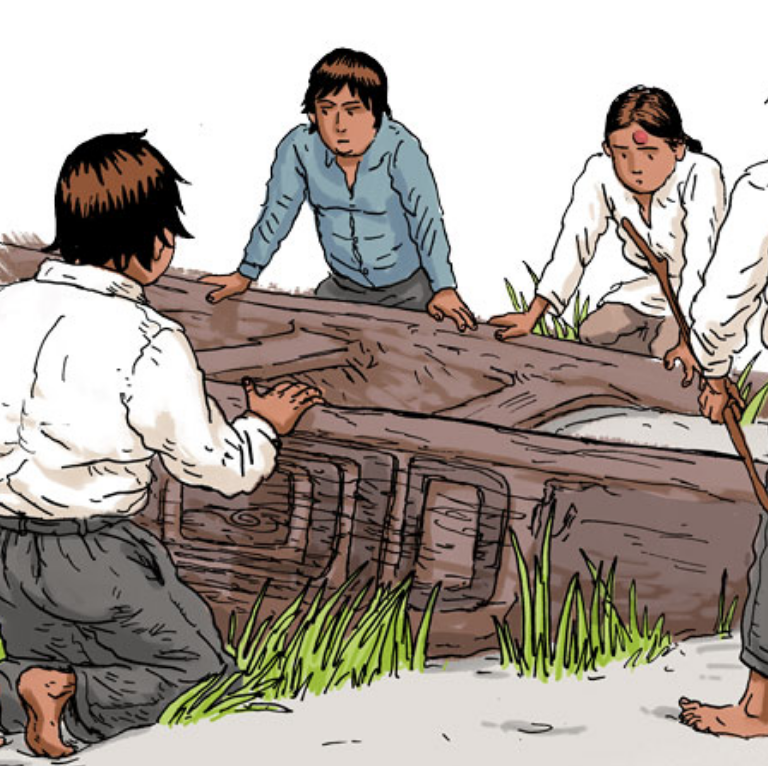
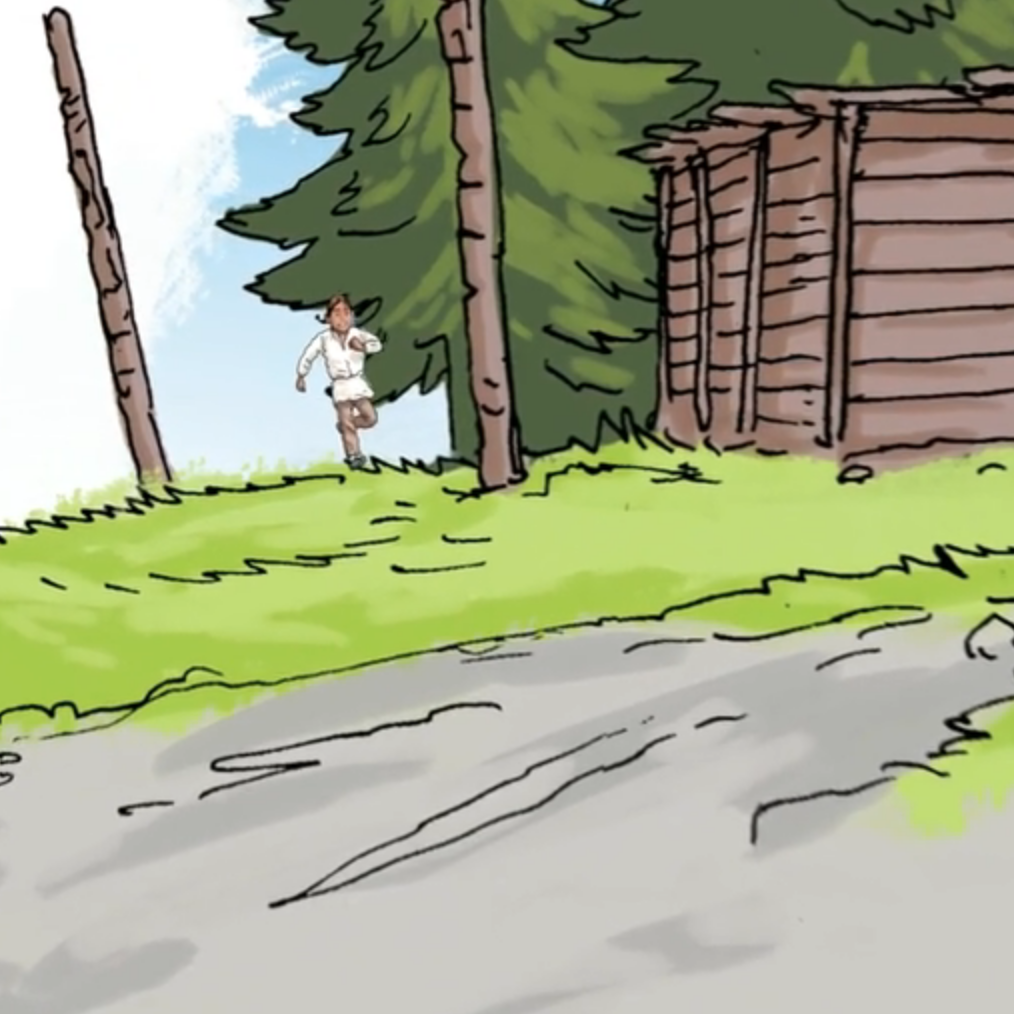
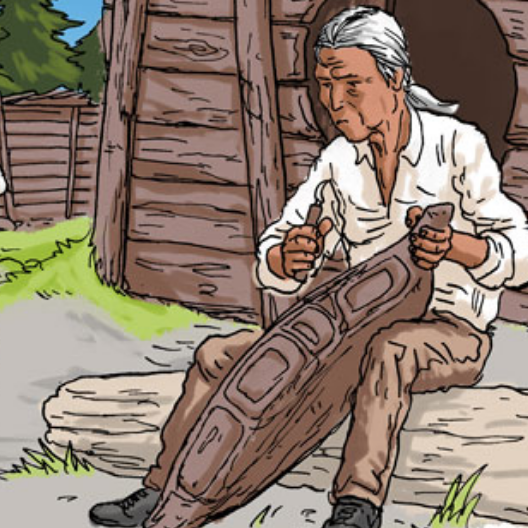
1:22 - “How many generations ago was [the canoe] built?”
1:43 - Notice the geometrical shapes, the angles, and the perspective. Which objects are parallel to each other? Perpendicular?
1:47 - “Grandpa is carving the surface of a huge wooden dish.” What is the shape of the dish? Notice the patterns and shapes in the carving.
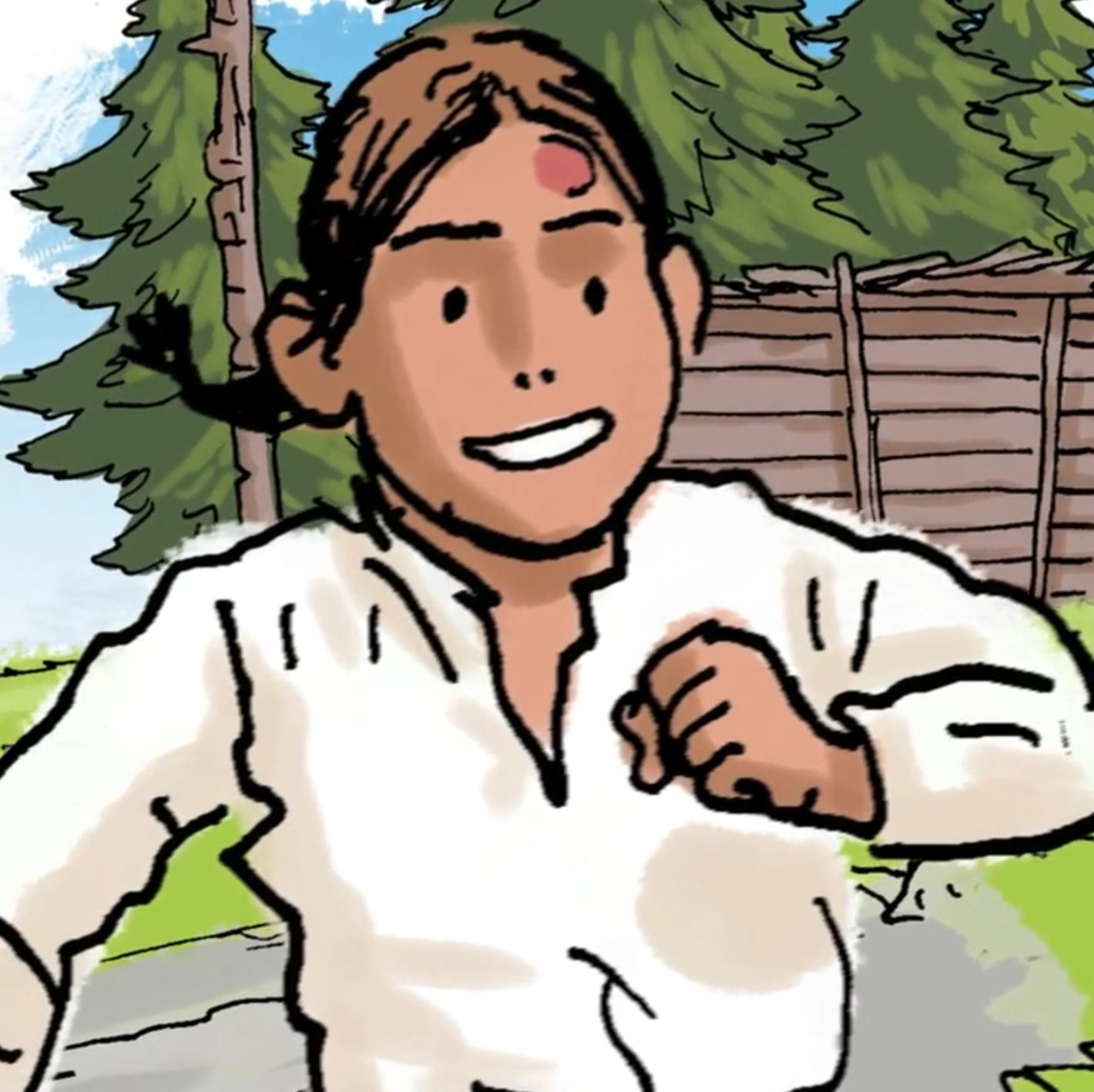
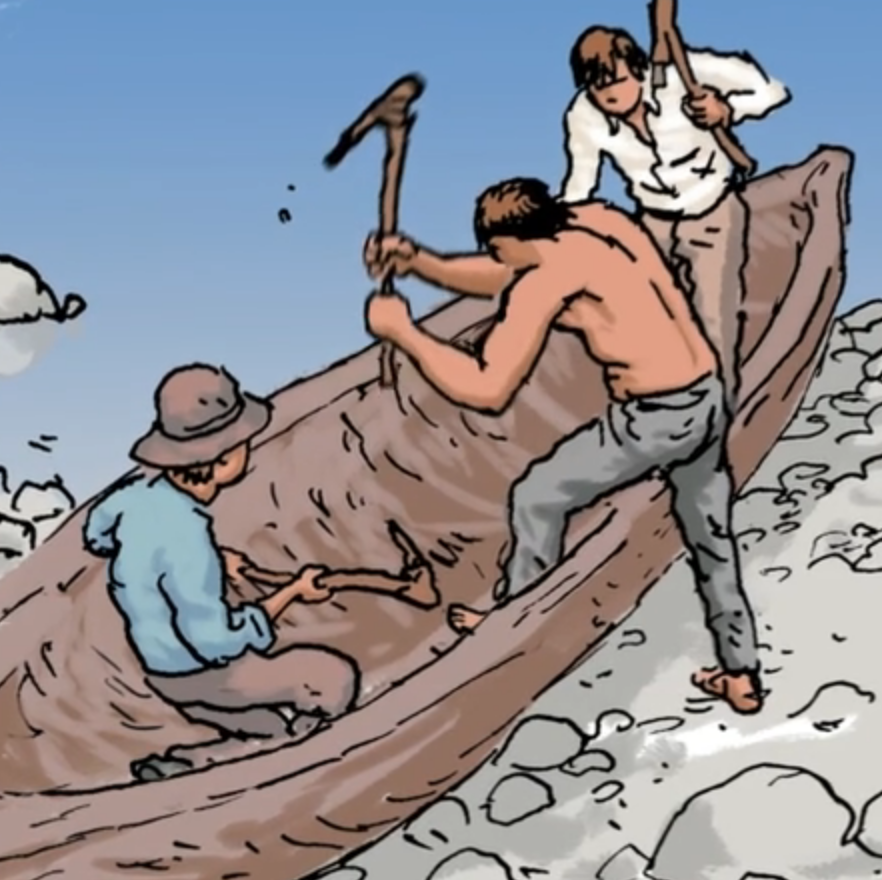
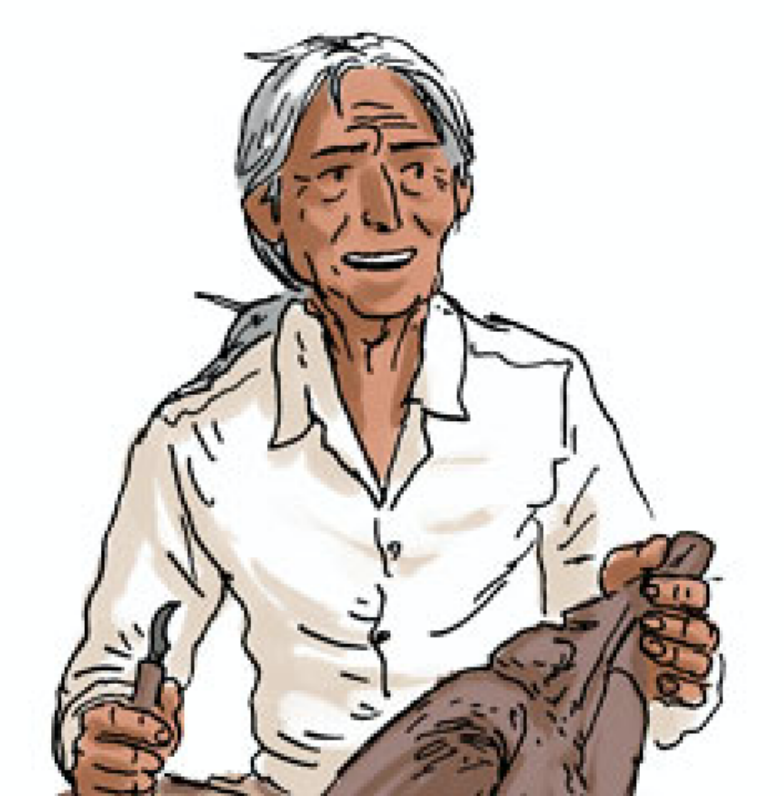
2:05 - “I found an old canoe down on the beach! It must be at least a hundred years old!”
2:10 - 2:16 - “I know that canoe. It was once the fastest canoe in our village. It was built by my father and two of his brothers.” How many bothers were building the canoe? What is the shape of the tools the brothers were using?
2:21 - “All the sons of my grandfather were known as great wood carvers.”
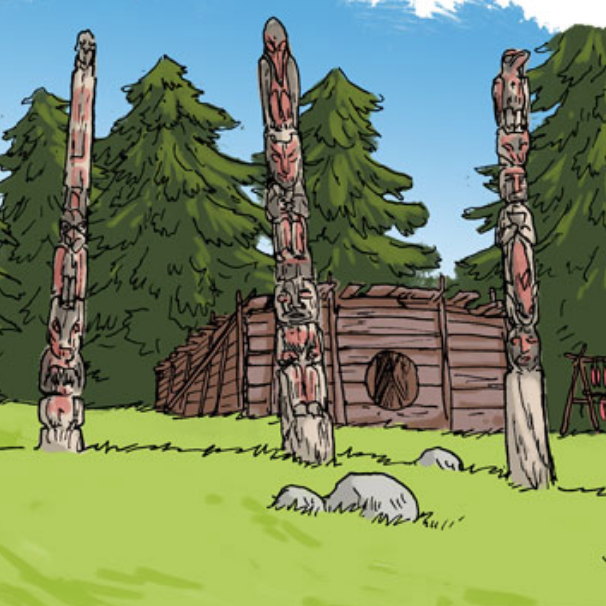
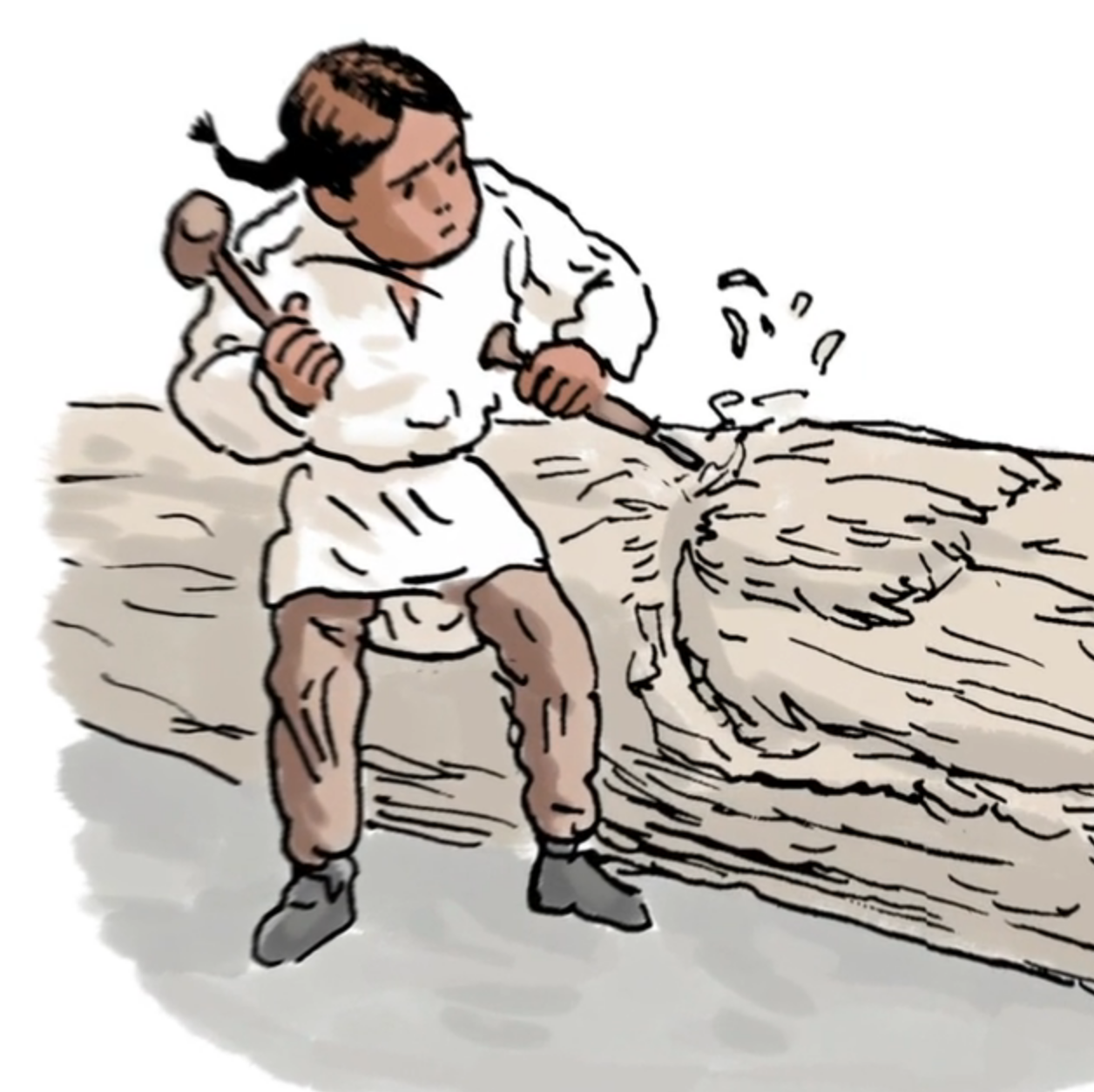
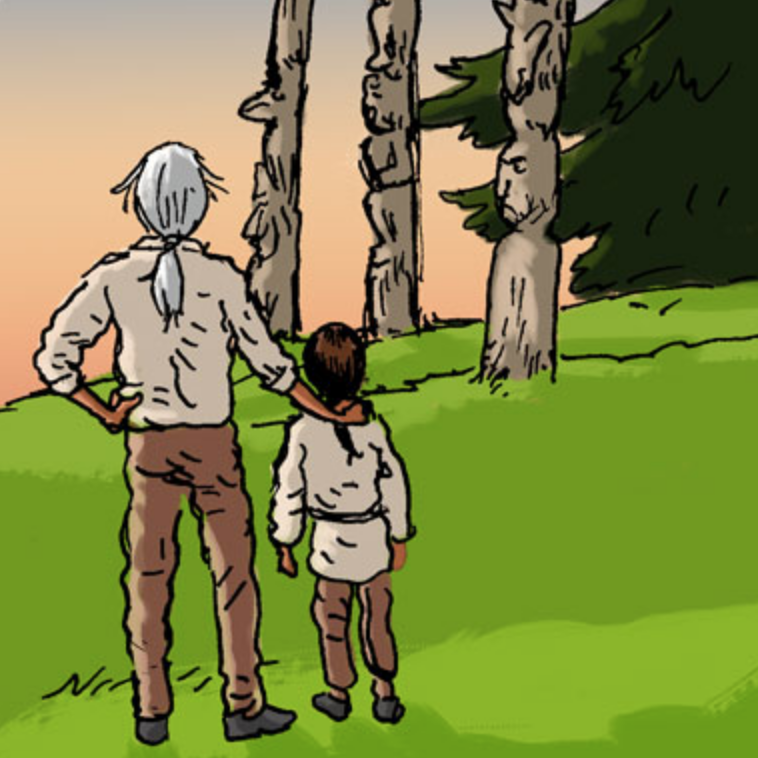
2:23 - 2:29 “You know those three old totem poles in front of the longhouse? Each of them was built by one of my uncles.” Notice the shapes and heights of the totem poles.
2:37 - What is the shape of the log? The diameter of the log? The circumference of the log?
2:42 - Notice the shapes and the perspective.
Subsection 2.1.5 Answer: Why did Small Number think that his great-grandpa might have two, three, four, five or more brothers?
Grandpa: “I know that canoe. It was once the fastest canoe in our village. It was built by my father and two of his brothers.”
Small Number thought:
“So, my great-grandpa had at least two brothers!” (See Figure 2.1.1)
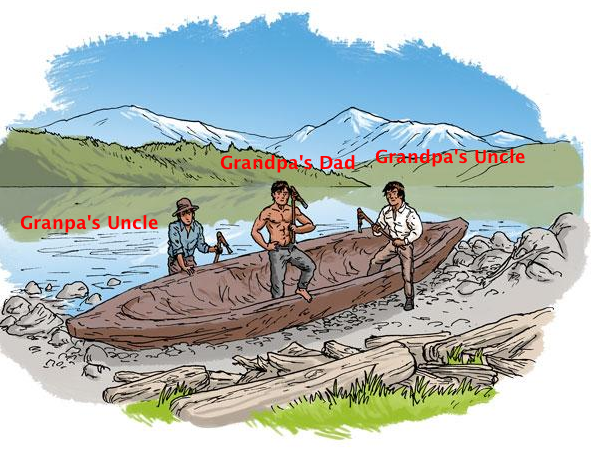
Grandpa: “You know those three old totem poles in front of the longhouse? Each of them was built by one of my uncles.” (See Figure 2.1.2)
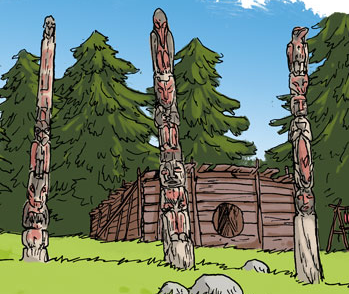
Small Number continued:
“Maybe the totem poles were built by the same two brothers that built the canoe together with my great-grandpa? Maybe my great-grandpa didn’t have any other brothers? So therefore, maybe my great-grandpa had only two brothers?” (See Figure 2.1.3)
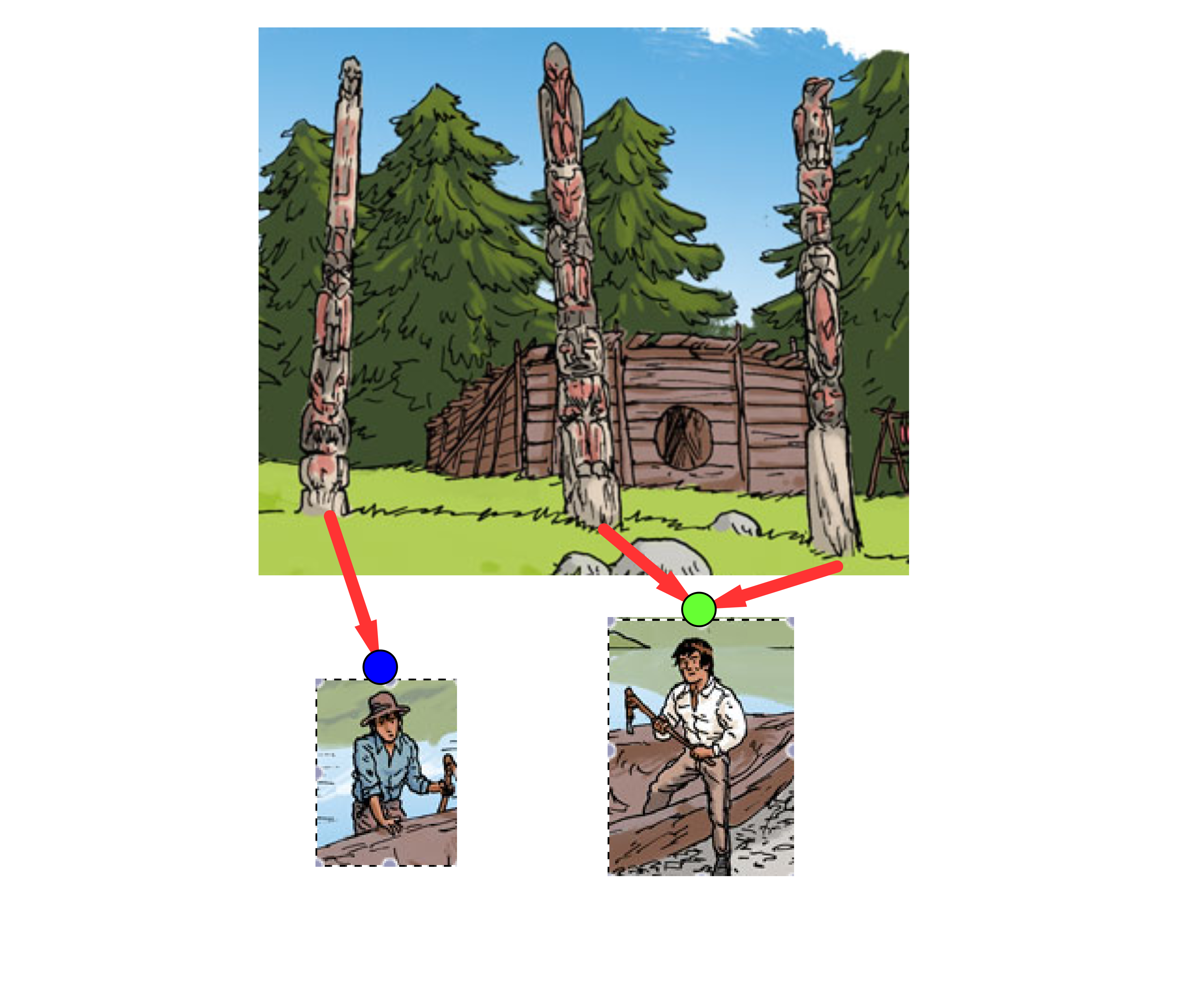
Small Number scratched his head:
“Maybe there was another brother? Maybe each totem pole was built by a different brother? It could be that my great-grandpa had three brothers.” (See Figure 2.1.4)
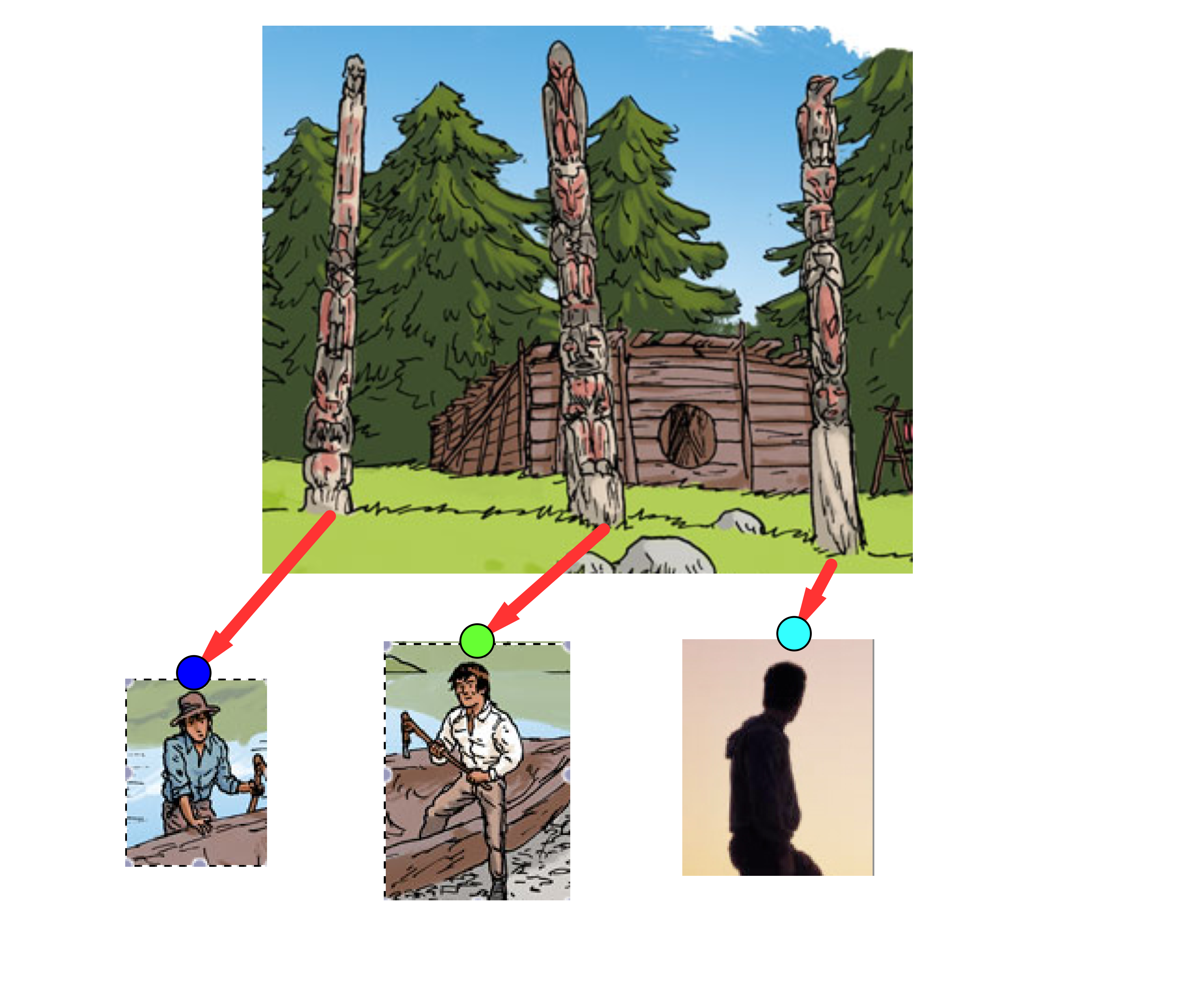
Small Number had another idea:
“Maybe my great-grandpa had four brothers? Maybe each totem pole was built by a different brother, but only one was built by one of Grandpa’s uncle who built the canoe?” (See Figure 2.1.5)
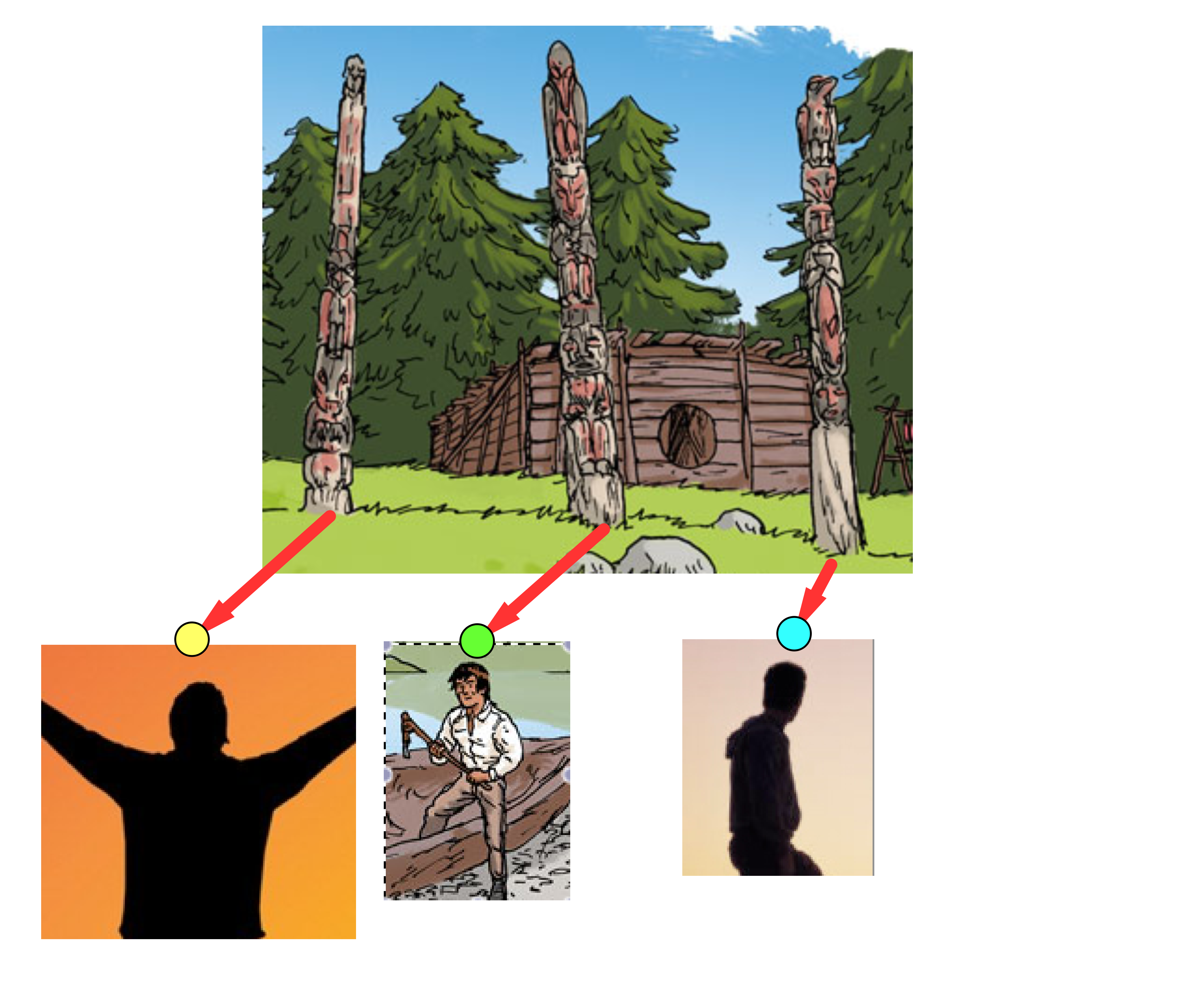
Small Number was getting sleepy:
“But maybe each totem pole was built by a different brother and none of those brothers worked on the canoe? It could be that my great-grandpa had five brothers. Maybe there were other brothers? I have to ask Grandpa tomorrow how many brothers his father had. Two, three, four, five or more…”
Subsection 2.1.6 Discussion/Activities
Exercise 2.1.6. Grades 3-5.
-
Start with the following exercise:
Prepare six cards: on three cards draw the same image of a canoe. On each of the remaining cards draw a (different) totem pole.
Continue by asking: “Who would like to be Small Number’s great-grandpa?” (Hand over one of the “canoe” cards to the volunteer, Alice.)
Next: “Now I need two of you to be Great-Grandpa’s brothers who helped him build the canoe.” (Hand over the other two “canoe” cards to Bob and Carol.)
To the class: “Let us talk about the phrase at least two. For example, I watched each Small Number film at least two times. How do you understand that? How many times did I watch each Small Number film?”
[Moderate the conversation. Make sure that students understand that “at least two” means “two or more”.]
To the class: “Do you agree that Small Number’s great-grandpa had at least two brothers?”
To the class: “Do you remember when Grandpa said: ‘You know those three old totem poles in front of the longhouse? Each of them was built by one of my uncles.’”
Show the three cards with the totem poles to the class: “If Small Number’s great-grandpa had only two brothers, what should I do with these three cards?”
[Moderate the conversation. If needed lead the class to the conclusion that one of the already established brothers (Bob and Carol, those with a “canoe” card) should get two “totem” cards. Hand over one card to Bob and two to Carol.]
Conclude: “It is possible that Small Number’s great-grandpa had exactly two brothers?” [The class should answer “Yes!”]
Take one totem card from Carol and give it to Dave. “Now, Bob is a brother who built a canoe and one of the totem poles, Carol is a brother who also built a canoe and one of the totem poles, and Dave is a brother who built the third totem pole. How many brothers are there now?” [The class should answer “Three!”]
To the class: “Is it possible that Great-Grandpa had four brothers?” [This should lead to the conclusion that Bob’s totem card should be given to Erin.]
To the class: “What about five brothers?” [This should lead to the conclusion that Carol’s totem card should be given to Frank.]
To the class: “What about more than five brothers?” [This should lead to the conclusion that maybe there were other brothers, those who didn’t build either the canoe or one of the totem poles.]
Exercise 2.1.7. Grades 5-7.
-
Start by reminding students how Venn diagrams are used to represent sets.
You may wish to discuss that in mathematics we use the word set as a synonym for a “collection of objects”. You may also wish to remind (or introduce to) the class some basic terminology related to sets.
For example, consider the following sets:
\(A\) = {students who were born in June} = {Alice, Bob, Carol}
\(B\) = {students who were born in July} = {Dave, Erin, Frank}
\(C\) = {students with an older brother} = {Alice, Erin, Frank}
\(D\) = {students with a younger sister} = {Dave, Frank}
\(E\) = {students who play soccer} = {Alice, Erin, Frank}
These five sets can be represented by Venn diagrams. (See Figure 2.1.8)
Figure 2.1.8. Five sets Continue by observing:
Sets \(A\) and \(B\) do not have any elements in common. [If you wish you may introduce the terminology, “\(A\) and \(B\) are two disjoint sets”.]
-
Sets \(A\) and \(C\) have only one element in common: Alice. See Figure 2.1.9. [If you wish you may introduce the phrase “Alice is the only element in the intersection of \(A\) and \(C\text{.}\)” You may introduce the notation \(A\) \(\cap\) \(C\text{.}\)]
Figure 2.1.9. Alice is the only element in the intersection of \(A\) and \(C\) -
Observe that sets \(B\) and \(C\) and sets \(B\) and \(D\) have exactly two elements in common. See Figure 2.1.10.
Figure 2.1.10. Erin and Frank are in the intersection of \(B\) and \(C\text{,}\) Alice and Dave are not; Dave and Frank are in the intersection of \(B\) and \(D\text{,}\) Erin is not Observe the difference between these two cases: All elements of the set \(D\) belong to the set \(B\text{.}\) [If you wish you may introduce the phrase “\(D\) is a subset of \(B\)”. Also, you may introduce the appropriate notation \(D\) \(\subset\) \(B\text{.}\)]
- Observe that sets \(C\) and \(E\) have all of their elements in common. We say that “sets \(C\) and \(E\) are equal”.
-
Watch the movie.
Repeat the question from the end of the movie: “Why did Small Number think that his great-grandpa might have two, three, four, five or more brothers?” Make sure that everyone understands the question. Then invite students to share their thoughts.
Say: “What if we try to use Venn diagrams to help Small Number?”
Continue: “What are the sets of interest that may help in finding the answer?” [Allow students to suggest “sets of interest”. You should end up with the following three sets. Students will probably need your guidance.]:
\(B\) = {all of Great-Grandpa’s brothers}
\(C\) = {Great-Grandpa’s brothers who built the canoe}
\(T\) = {Great-Grandpa’s brothers who built the totem poles}
Start by noticing that sets \(C\) and \(T\) are subsets of the set \(B\text{.}\)
Ask: “Do we know how many elements the set \(C\) has?” [The answer should be “two”.]
Next, ask: “Do we know how many elements the set \(T\) has?” [The answer should be: “We don’t know”.]
Remind students about Grandpa’s words: “You know those three old totem poles in front of the longhouse? Each of them was built by one of my uncles.” Observe that Grandpa used the word “uncles” and ask: “Do you agree that there was more than one uncle involved in building the totem poles?” [Students may agree with this or they may not. It does not matter. Go with the majority opinion.]
Ask the class: “How do you understand Grandpa’s words: ‘Each of them was built by one of my uncles’? Is it possible that one brother built two totem poles?” [Again, let students share their thinking. Lead students to the conclusion that there were at most three elements in set \(T\text{.}\)]
Your strategy should be to discuss the following five cases:
- Sets \(C\) and \(B\) are equal. In this case the set \(T\) also must be equal to the set \(C\text{.}\) See Figure 2.1.11.
Figure 2.1.11. Two brothers: \(B\) = \(C\) = \(T\) -
Set \(C\) is a subset of the set \(T\text{,}\) but they are not equal. See Figure 2.1.12.
Figure 2.1.12. Three brothers: \(C\) is a subset of \(T\) -
The set \(T\) has three elements and sets \(C\) and \(T\) have one element in common. Make sure that you warn students about avoiding double-counting. Figure 2.1.13.
Figure 2.1.13. Four brothers: \(C\) and \(T\) have one element in common -
The set \(T\) has three elements and sets \(C\) and \(T\) have no elements in common. Figure 2.1.14.
Figure 2.1.14. Five brothers: \(C\) and \(T\) have no elements in common -
The set \(T\) has three elements and sets \(C\) and \(T\) have no elements in common, but there is another brother. Figure 2.1.15.
Figure 2.1.15. More than five brothers: \(C\) and \(T\) have one element in common
- Sets \(C\) and \(B\) are equal. In this case the set \(T\) also must be equal to the set \(C\text{.}\) See Figure 2.1.11.
Exercise 2.1.16. General.
-
You may wish to discuss the following:
Ask students to pay attention to mathematics (words, geometrical shapes, patterns, numbers). Ask students to pay attention to the cultural, particularly Indigenous, aspects of the story. Ask students to make their own game that includes double counting.
Subsection 2.1.7 Challenge
Suppose there are 30 students, 10 who have a dog and 15 who have a cat. If there are 5 students that have both a dog and a cat, how many students have neither a dog nor a cat as a pet?

